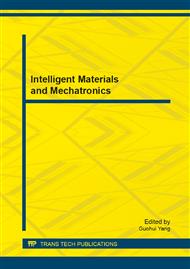p.258
p.265
p.273
p.279
p.285
p.293
p.298
p.304
p.310
Smooth Trajectory Planning for 3-UPU Parallel Manipulator
Abstract:
Exciting the mechanical resonance mode and vibration caused by non-smooth trajectories can cause some failure in the structure of the robot and its actuators. This work proposes a smooth trajectory planning for 3 degree of freedom (dof) 3-upu parallel manipulator. We have used optimization method to define the smooth trajectory for this robot. In this paper an objective function has been used which contain a term related to the total execution time and a term corresponding to the integral of squared jerk. Some constraints have been applied to the problem as the input of our system. Task space and joint space trajectory are then considered as the output. In this method optimization techniques such as genetic algorithm and fmincon (function of MatLabTM ) have been investigated. Six via points have been considered and B-splines have been used to present kinematic quantities.
Info:
Periodical:
Pages:
285-292
Citation:
Online since:
November 2013
Keywords:
Price:
Сopyright:
© 2014 Trans Tech Publications Ltd. All Rights Reserved
Share:
Citation:


